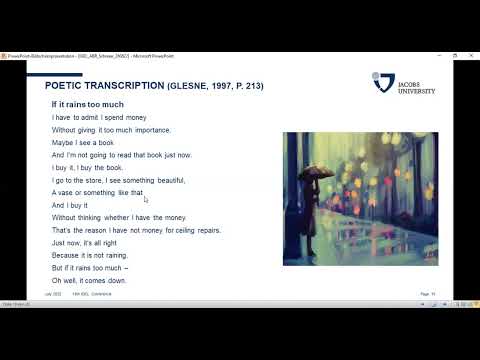 Speaker : Margrit Schreier
Speaker : Margrit Schreier
 Affiliation : Jacobs University Bremen
Affiliation : Jacobs University Bremen
Title : The Potential of Arts-Based Research for the Empirical Study of Literature
Abstract : Over the past 20 years, arts-based research has gained increasing importance as a new paradigm in the social sciences. It spans a wide variety of approaches and methods. This includes both the practice of art as a method for data collection and the use of artistic formats for the distribution of research findings. In this presentation I describe this paradigm and argue for the usefulness of arts-based research in the Empirical Study of Literature.

 Long abstract
Long abstract
Over the past 20 years, arts-based research has gained increasing importance as a new paradigm in the social sciences (Barone & Eisner, 2012; Knowles & Cole, 2014; Levy, 2020). It spans a wide variety of approaches and methods, including both the practice of art as a method for generating knowledge and the use of artistic and literary formats for the distribution of research findings.
In a first, narrow format of arts-based research, proponents of this paradigm have made use of literary and artistic formats for publicizing their findings. Here, the first core underlying idea is that research should ideally benefit the wider public. And if it is to fulfil that purpose, it needs to be available to a wider public as well, i.e. it has to be more accessible than the standard publication in a scientific journal. A second core idea is that again, ideally, research findings should not only have a cognitive effect, but an emotional effect as well: They should move the recipients, perhaps change or even empower them in some way.
Based on these assumptions, referential forms of artistic expression have been especially prominent for the distribution of findings in arts-based research. This includes in particular autoethnographic research which, in addition to propagating accessibility of research findings, also makes use of the author’s personal experience as data; ethno-theatre (also subsumed under the broader label of performative research) which is typically based in a participatory research tradition and involves the development of the final product together with the participants; and fiction-based research where findings are presented in the format of a novel.
But less referential formats have also been used that allow for a multiplicity of meanings and leave the recipients even more room for interpretation, such as poetry (e.g. the method of condensing participants’ voices into “found poems”), film, or even dance, giving prominence to the embodied nature of knowledge.
A second format of arts-based research has even broader implications than what has been described so far. In arts-based research in a wider sense (sometimes termed artistic research), the very idea of conceptual knowledge that can be verbalized is called into question. Here, the goal is to use methods based in the arts even for data collection, so as to allow for the inclusion of other, pre-cognitive and non-verbal forms of knowledge. Again, a broad range of methods has been used in this context, including more widely known methods such as photovoice as well as painting, the writing of poetry, or the performance of dance or music. Here, the very process of producing and generating art is considered part of the process of generating knowledge.
Both types of arts-based research hold great promise for the empirical study of literature. Artistic research, i.e. arts-based research in the broader sense, did in fact arise from the study of artistic creativity and can be extended from the visual arts to the writing of poetry, plays, or fiction. Using arts-based methods for data collection would likewise be of great interest when it comes to studying reception processes in greater detail. Traditional methods easily miss out on those very pre-cognitive aspects of meaning, that intuitive knowing or resonance that it can be difficult to capture in words. Similar considerations apply to the distribution of findings in the empirical study of literature. Why should not a study about, for example, the emotional effects of literature, be written up in way that is in itself emotionally moving? This might, after all, in combination with conventional ways of distributing our findings, do better justice to our material.
References
Barone, Tom & Eisner, Elliott W. (2012). Arts-based research. Los Angeles, CA: Sage.
Knowles, Gary W. & Cole, Ardra L. (2014) (Eds…), Handbook of the arts in qualitative research. Thousand Oaks, CA: Sage.
Leavy, Patricia (2020). Method meets art (3rd ed.). New York, London: The Guilford Press.

